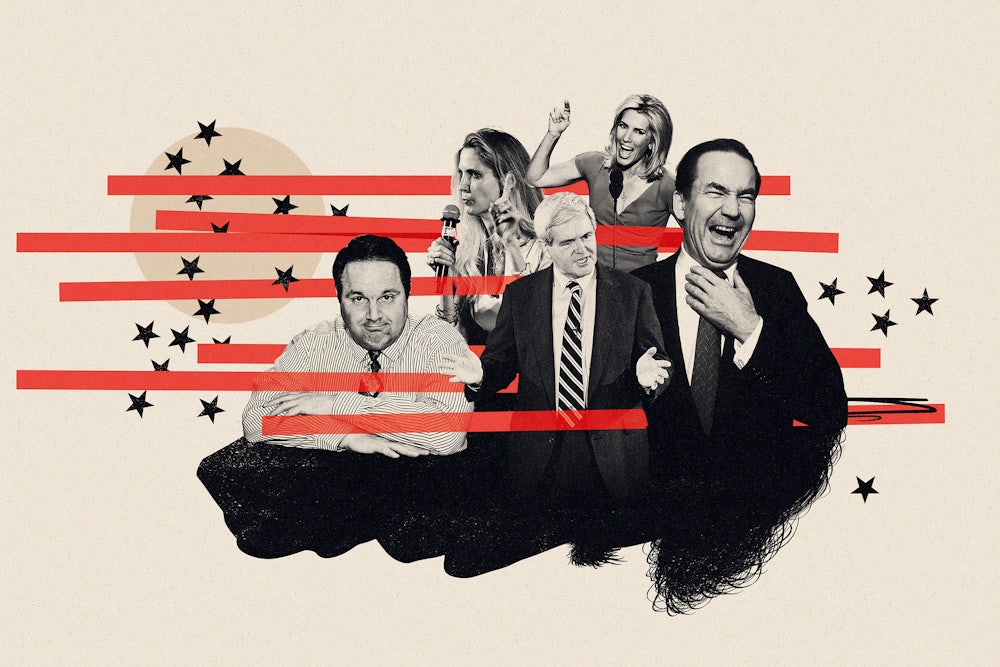Two days before the 2020 election, Daily Beast columnist Matt Lewis predicted the “nightmare scenario” that would produce the January 6 insurrection and, nearly two years later, 250 GOP general election candidates whose unifying characteristic is the falsehood that Donald Trump is the legitimate president of the United States. “There’s a real possibility,” Lewis wrote about the partisanship tearing the United States to pieces, “that we will end up in a sort of campaign season purgatory where it’s always winter but never Christmas.”
That purgatory has arrived. Although some of the most prominent Never Trump pundits—such as William Kristol, editor at large at The Bulwark, and New York Times columnist David Brooks—remain shocked by the obliteration of a more cerebral conservatism, the media-driven partisanship that dominates U.S. politics today is hardly new. Since advertising professionals entered the political consulting business in the 1950s, political messaging has been designed to translate ill-formed, often unconscious, ideological predilections into conservative voting majorities by ever more intense appeals to voters’ emotions and grievances.

Those appeals always circulated on the extremist right. For mainstream politicians who wanted to win these voters, the rule of the game—one that infuriated activists like Phyllis Schlafly—was to disavow the fringe, while signaling to its members. In 1964, even as Barry Goldwater denied that the John Birch Society was promoting his candidacy and deploying canvassers for him, his campaign slogan—“In your heart, you know he’s right”—was designed to reassure those activists that Goldwater embraced their values. The nature of campaigning in the 1950s and ’60s required hiding extremism’s dark side. Television and radio ad buys on channels governed by the Fairness Doctrine made it not just possible, but almost compulsory, to court voters outside the party: A successful campaign could not purposely make itself noxious, as campaigns do today. And although alternative political media provided platforms for extremism, mainstream news outlets did not.
Though Goldwater lost, the seed was planted: His promises reemerged five years later in Richard M. Nixon’s message to the “silent majority” of Americans that he understood their anger at the Democratic civil rights agenda and the New Left’s militant antiwar stance. Reagan and George H.W. Bush followed suit: They crafted coded slogans designed to bring those partisans to the polls and persuade them that the GOP cared about their grievances. During these decades, the Republican Party engaged in a dance with the devil, in which the GOP promoted its own electoral success through Goldwater’s populist descendants—Patrick J. Buchanan, Sarah Palin, libertarian Ron Paul, and the Tea Party—while believing that party leaders could contain the ambitions of the “pitchfork politics” voters they promoted.
Nicole Hemmer’s new book, Partisans: The Conservative Revolutionaries Who Remade American Politics in the 1990s, is about the moment the Republican Party lost its ability—or desire—to keep its fringe at bay. At the end of the twentieth century, right-wing partisans came roaring onto the main stage, disgusted by the failure of their agenda in Ronald Reagan’s and George H.W. Bush’s White Houses. With appeals that grabbed and consolidated voters’ resentment about cultural and social issues, they successfully advanced extreme positions on domestic and foreign policy. By the end of the ’00s, right-wing partisans were crossing back and forth between formal politics and a range of proliferating, highly personal media platforms. The political culture they built was infused with a “more pessimistic, angrier, and even more revolutionary conservatism” than Barry Goldwater ever imagined.
Though the shadow of Donald Trump hangs over Partisans, Hemmer does not focus on the last president. Instead, she shifts the lens to a set of much bigger questions. How did one of America’s two major parties become dominated, not just by vicious, public attacks that used to be the province of undercover dirty-tricks specialists, but by a proud rejection of democracy itself? How did virulent nativism, homophobia, and racism spread from the far-right, where the Republican Party successfully contained it for decades, to take over a whole political party? When did culture wars, promoted between both right-wing pundits acting like politicians and right-wing politicians acting like pundits, stop simply motivating voters and shift the center of gravity in the GOP to conspiracism and illiberalism?
Partisans is a story about politicians who learn to be media figures, and media figures who learn to be politicians. It’s about a Republican Party that came to believe so little in policy and governance that in 2020, for the first time in its history, amid a crumbling economy caused by the worst pandemic in a century, the GOP failed even to produce a party platform. “Rather than deal with these issues,” Tom Wheeler of the Brookings Institution wrote in August of that year, “rather than tell the American people and foreign governments what it stands for, it appears as though the Republican Party has codified that it is for whatever Donald Trump wants to do.”
An account of such an extraordinary moment in a democratic society is difficult to produce, because it must simultaneously grapple with how media creates a space for a new kind of politics, why political circumstances make new candidates possible, and under what conditions one particular person, and not someone else, can exploit the new political media terrain. An experienced television pundit, general audience writer, and podcaster herself, Hemmer is part of a generation of scholars whose feel for the history of politics and media is infused with a practitioner’s insights. In her 2016 book, Messengers of the Right: Conservative Media and the Transformation of American Politics, she linked what seemed to be a new phenomenon—the celebrity conservative pundits who burst onto the scene in the 1990s—to a far older tradition of right-wing radio and television franchising that cohered in the pre-digital, pre-cable conservative media ecosystem.
In Partisans, Hemmer picks up that story where she left off in Messengers of the Right, but with a fresh insight: that Reagan’s triumph was the end of an old regime, not the beginning of a new one. As Hemmer argues, the opening for populists to make their case was the strategic vacuum created by the end of the Cold War in 1989: Republicans no longer had the fight against communism to unify conservatives of many different tendencies. Reagan had also laid the groundwork for a new kind of presidency, one that promised disruption. Yet, although he attended to traditional conservative values—defunding the welfare state and spending lavishly on the military—Reagan largely avoided divisive cultural issues. Right-wing anger festered as it became clear in the 1980s that eliminating abortion and affirmative action, and restoring school prayer, were nowhere on the Republican Party’s agenda. A young congressman named Newt Gingrich complained that Reagan had not polarized the country enough. “He should have been running against liberals and radicals,” Gingrich wrote in a journal published by the conservative Heritage Foundation after the 1984 election.
Although Reagan’s sunny, optimistic style contrasts sharply with Trump’s lament of “American carnage,” he, too, successfully distracted voters from his lack of policy achievements by blowing the smoke that his voters wanted to inhale. As economic journalist William Greider wrote in December 1984, a few weeks after Reagan thumped Democrat Walter Mondale by 18 points, the president cruised to victory on a gauzy cloud of lies and obfuscation. Even journalists had “yielded to the techniques of mass propaganda,” Greider wrote, “large lies told through the calculated repetition of soothing imagery and potent symbolism. The harsh facts of contradictory realities were no match for it.” If the recent election “describes the future,” he continued, “then Americans are being reduced to a nation of befogged sheep, beguiled by false images and manipulated ruthlessly.”
Well, hello. And while that new voting public would not emerge full-blown until 2016, populism’s capacity to disrupt old arrangements became clear by 1992. In Hemmer’s telling, the possibility of a populist president in the Trump mold emerged when mainstream GOP strategists understood that Pat Buchanan’s bid for the Republican nomination, and the independent candidacy of Texas tech billionaire Ross Perot, generated a fervor that Reaganism—with its focus on abstract economic theories and weak response to culture wars issues like feminism, immigration, and gay rights—lacked. Buchanan’s nativist, isolationist, racist, and homophobic appeal to old-style Cold War conservatives resonated with a younger generation of aggrieved white candidates and voters who were coming out of the shadows. It’s no accident, Hemmer points out, that only one week before Buchanan entered the race, David Duke—an active Nazi, and former Klansman—announced his own campaign for the Republican presidential nomination.
Even though the GOP retained it as a brand, Reaganism died a messy and ugly death as a cohesive Republican philosophy at the 1992 Republican National Convention. There, Buchanan, a defeated primary candidate, handed his delegates (otherwise known as the “Buchanan Brigades”) to incumbent George H.W. Bush with a fiery culture wars manifesto. After honoring Reagan and saluting Bush, Buchanan excoriated the Democratic ticket—Bill Clinton and Al Gore—as proponents of “militant” gay rights and “abortion on demand.” And to make it clear what the GOP’s stance on feminism ought to be, for perhaps the first time in history, Buchanan savaged the Democratic nominee’s wife on national television. “Hillary believes that 12-year-olds should have the right to sue their parents,” Buchanan thundered, “and Hillary has compared marriage and the family as institutions to slavery and life on an Indian reservation.”
“Well, speak for yourself, Hillary,” Buchanan sneered as the delegates cheered wildly. The party’s future was not Reaganism, even though that philosophy would get one more turn in George W. Bush’s two twenty-first–century presidencies. The future was Buchanan. A Republican insider turned outsider, and a cable news pundit, the former Nixon speechwriter was skilled, Hemmer writes, in “resuscitating the politics of the Old Right and grafting them on to the era’s modern media culture.” And not unlike Trump, for the next decade, Buchanan toggled between presidential campaigns and increasingly influential gigs as a cable news pundit and opinion writer.
Most important, Buchanan put the elites in his own party on notice, while Perot’s third-party run gave both sides cause for concern—his 18.9 percent of the popular vote may have defeated Bush, and certainly put Bill Clinton in the White House with less than a majority. In the wake of this defeat, the GOP determined to grab the populist tiger by the tail, which it did in the 1990s. Now under the direction of House Speaker Newt Gingrich and accompanied by thunderous support from a new generation of conservative pundits like Rush Limbaugh, Ann Coulter, and Laura Ingraham, the GOP invented and refined the politics of “no”—or as Limbaugh liked to put it, “Hell, no!”
The strategy was to batter Democrats with culture wars battles, while eroding the capacity of the state and Congress to govern. On one front, Gingrich forced the resignation in 1989 of Democratic Speaker of the House Jim Wright, and later, when he was serving as speaker himself, launched investigations of the Clinton administration that kept the White House mired in litigation and defense. On another, the politics of “no” brought progressive policies to a screeching halt and drove Clinton to the center. No to national health care; no to progressive Cabinet appointments like Zoë Baird; no to out gays and lesbians in the military; and no to lobbying reform. And in the most stunning no of all, in 1995, Gingrich pushed the government into a shutdown by refusing to allow his caucus to sign off on the Clinton administration’s proposed budget.
Gingrich’s most important legacy was, in the words of Thomas Schaller, “Do not cooperate, do not compromise, do not seek bipartisan solutions—ever, on anything.” This partisan style not only remained influential but expanded its reach, as populists and libertarians turned on party politics itself as the province of callous political and cultural elites who disregarded the welfare of the people in favor of enriching themselves. As this cauldron of resentment took a turn into a new century, Newt Gingrich resigned from Congress.
The radicalism nurtured in the 1990s was more than the work of one man. Hemmer makes clear that GOP insiders made conscious decisions about the party’s direction that created openings for these media figures to exploit. The conservative consultant Frank Luntz realized that Perot and Buchanan voters had one thing in common in 1992, and Republicans needed to make that thing core to their future strategies: contempt for politicians. Republicans had to abandon the sunny style of Reaganism, vilify the opposition, and embrace the forgotten man.
Luntz’s principles came to define a campaign style that right-wing partisans used against Democrats, but also against traditional conservatives in their party, over the next three decades. “Everything ‘politicians’ do, we must do the opposite,” Luntz urged. “If politicians dress in suits, we must dress casual. If politicians give speeches, we must hold discussions…. We win only if we are different.” Most important, Republican campaigns had to describe the party with words like “pride,” “strength,” and “vision,” and use contrasting language—“radical,” “disgrace,” and “traitor”—to describe Democrats.
These divisions were cultivated, and they were crafted. But what radical populists lacked was power within their own party. It took 9/11, George W. Bush’s war on terrorism, the 2008 financial crisis, and the election of the nation’s first Black president, Barack Obama, to create an organized, electoral coalition within the GOP that would be a home for these partisans: the Tea Party.
By 2001, most of the intellectuals and activists who had built Ronald Reagan’s “New Right” were fading from the scene: Phyllis Schlafly and William F. Buckley Jr., while still active, were in their late seventies; and Paul Weyrich, who used a wheelchair and was in chronic pain, had withdrawn from public life. Their absence, and the steady collapse of the U.S. newspaper industry, created a vacuum that popular partisan talk shows on cable TV channels rushed to fill after 9/11. As historian Julian Zelizer and journalist Gabriel Sherman have each pointed out in accounts of partisanship after 1990, smart politicians knew how to harness the new media, and the new media in turn learned how to harness politicians. Gingrich and his GOP caucus learned to broadcast themselves on C-SPAN, giving fiery speeches to an empty House, while Roger Ailes’s Fox News expanded its audience by going big on the Tea Party.
Everybody came out a winner. By the time George W. Bush became president, extremist voters already lived in a right-wing media world with its own logic and language, driven by personalities like the folksy Rush Limbaugh and powered by radio. Cable expanded that cast of characters to include a new generation of highly educated figures, themselves elites, who crossed over from right-wing activist and think tank–based circles to highly lucrative careers in punditry, publishing, and public speaking: Ingraham, Coulter, and Dinesh D’Souza among them. Several were recognizable from the old media world. Tucker Carlson was a rabble-rouser at The Weekly Standard before shifting to television, first at CNN, then at MSNBC, and finally at Fox News, while Glenn Beck and Sean Hannity were seasoned radio talk show hosts before joining Fox.
The polarization that produced Trumpism, Hemmer argues, was not sui generis, but built on a brand carefully manufactured in the 1990s and put to work by a hungry new cadre of Republican populists and media professionals in the 2000s. It was also at the turn of the last century that accusations of election fraud—a charge that had largely been leveled at Black Democratic voters in the South and the urban North—began to accompany Republican defeats everywhere. When Michael Huffington lost his California Senate race to Dianne Feinstein in 1994, Hemmer notes, “he refused to concede, alleging overwhelming voter fraud in the form of mass noncitizen voting.” Similarly, in 1996, Bob Dole “charged Democrats with flooding the country with immigrants” who would vote for Bill Clinton and alleged that at least a tenth of these fraudulent voters were “criminals.”
Today, we live in a political world that Ronald Reagan would hardly recognize, despite the constant invocation of his name in Republican circles. Every race is a national race, each one essential to the partisanship that drives, and pays for, political campaigns today. Every high-profile event, no matter how unrelated to politics, is a new opportunity to activate partisans: On the last day of this year’s prestigious U.S. Open championship golf tournament, the national GOP circulated an ad on Twitter offering golf balls for sale, printed with the words “Let’s go Brandon!,” a code phrase for an obscenity directed toward President Joe Biden.
As I finished Partisans, I remembered the experience of watching President Trump speak live at CPAC 2018. At the end of a stem-winder, during which he veered off and on script for over 70 minutes, Trump asked the crowd if they wanted to hear him read “The Snake,” a version of a fable about a tenderhearted woman who nurses a reptile back to health, only to die when the snake bites her. Taken from a 1963 song by Oscar Brown Jr, in Trump’s hands, the story becomes a parable for the perils of undocumented immigration, and the foolishness of showing sympathy for outsiders. Trump’s favorite line, much anticipated by the audience, comes when the woman is dying, begging to know why her love and care were repaid with murder. “‘Oh, shut up, silly woman,’ said that reptile with a grin,” Trump read, as the audience howled. “You knew damn well I was a snake before you took me in.”
Yet, after reading Partisans, I realized that “The Snake” is not just a parable intended to stoke fear about the dangers of outsiders, a characteristic of all extremist movements. It is also the closest that Trump will ever come to a love story for the populist movement that brought him to power: the snake that the Republican Party establishment believed it could control—until it couldn’t.






